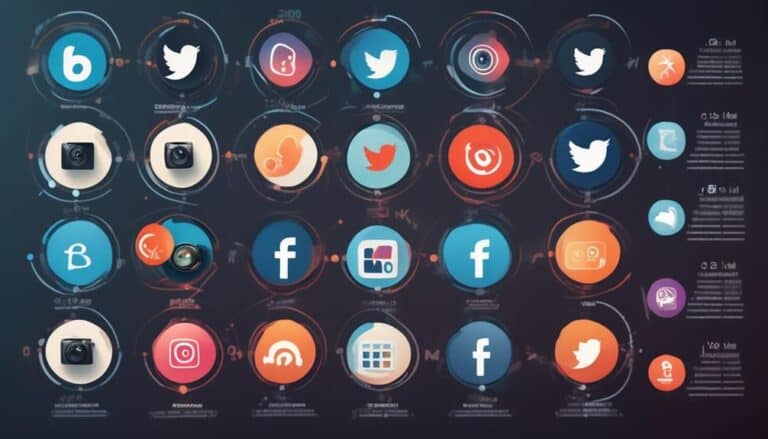Audience Analytics 101: Getting Started With Data-Driven Engagement
When it comes to audience analytics, did you know that only 27% of marketers believe they have a good understanding of their customers' behavior across channels? Understanding your audience is essential for effective engagement, but where do you begin?
By exploring the fundamentals of data-driven engagement, you can uncover valuable insights that lead to more personalized and impactful interactions with your target demographic.
Key Takeaways
- Audience understanding is essential for effective decision-making in audience analytics.
- Segmentation helps in creating targeted messaging tailored to resonate with specific audience groups.
- Utilizing tools like data visualization and real-time tracking enhances data collection and provides actionable insights for engagement strategies.
- Personalization strategies, such as content segmentation and personalized recommendations, lead to enhanced user engagement and interaction.
Importance of Audience Understanding

Understanding your audience is crucial for effective decision-making in audience analytics. Audience segmentation plays a vital role in this process, allowing you to divide your audience into specific groups based on demographics, behaviors, or preferences. By segmenting your audience, you can create targeted messaging that resonates with each group, increasing the likelihood of engagement and conversion.
Targeted messaging involves crafting content that's tailored to the unique characteristics of each audience segment. This personalized approach enhances the relevance of your communication, making it more compelling and persuasive to the recipients. By analyzing the data gathered through audience segmentation, you can identify patterns and trends that inform the creation of targeted messages that are more likely to drive desired outcomes.
Types of Audience Data
Segmenting your audience based on demographics, behaviors, or preferences provides the foundation for collecting various types of audience data essential for audience analytics. Understanding the types of audience data available can significantly enhance your engagement strategies. Here are key categories of audience data to consider:
- Demographic Segmentation:
- This data focuses on quantifiable statistics like age, gender, income, education level, and geographic location.
- It allows you to tailor your content to specific groups based on their unique characteristics.
- Behavioral Insights:
- This type of data tracks how users interact with your content, website, or products.
- It helps you understand what drives audience engagement, such as browsing patterns, purchase history, or content consumption habits.
- Preference Data:
- Preferences encompass individual likes, dislikes, and interests.
- By analyzing this data, you can personalize experiences, recommend relevant content, and create targeted marketing campaigns.
Tools for Data Collection

Utilize specialized software tools to efficiently gather and organize audience data for comprehensive analysis. When selecting tools for data collection, consider incorporating data visualization tools for enhanced insights and real-time tracking capabilities to stay updated on audience behavior. These tools can streamline the process of data collection, making it more manageable and insightful for your analytics needs.
To highlight the significance of choosing the right tools for data collection, let's compare the features of data visualization tools and real-time tracking capabilities in the table below:
| Data Visualization Tools | Real-Time Tracking Capabilities |
|---|---|
| Transform complex data into visual graphs and charts for easier interpretation | Monitor audience interactions as they happen |
| Identify trends and patterns through interactive visual representations | Receive instant updates on audience engagement |
| Enhance decision-making with clear, visually appealing insights | Adapt strategies promptly based on real-time data |
| Improve communication of data-driven findings across teams | Track the effectiveness of campaigns in real time |
Selecting tools that offer both data visualization and real-time tracking capabilities can greatly enhance your audience analytics efforts, providing you with actionable insights to drive engagement and growth.
Analyzing Audience Behavior
To effectively dissect audience behavior, delve into patterns and interactions to extract valuable insights crucial for strategic decision-making. Understanding behavioral patterns and audience segmentation is key to optimizing engagement strategies. Here's how you can effectively analyze audience behavior:
- Leverage Data Visualization Tools: Visual representations of data can help identify trends and patterns that mightn't be apparent in raw numbers.
- Use heatmaps to track user interactions on your website.
- Employ funnel analysis to understand the customer journey and optimize conversion rates.
- Utilize Machine Learning Algorithms: Implement predictive analytics to forecast future behaviors based on past interactions.
- Apply clustering algorithms to group audiences with similar characteristics for targeted campaigns.
- Engage in A/B Testing: Experiment with different content, layouts, or messaging to gauge audience responses and refine strategies.
- Test variations of email subject lines to determine which resonates best with your audience.
Personalization Strategies

When considering personalization strategies, your focus should be on tailored content delivery and customized user experiences.
Understanding how to effectively deliver content that resonates with your audience and creates a more engaging user journey is crucial.
Tailored Content Delivery
Enhance user engagement and satisfaction by implementing personalized content delivery strategies tailored to individual preferences and behaviors. To achieve this, consider the following:
- Content Segmentation:
- Divide your audience based on demographics, interests, or behavior.
- Analyze user interactions to understand what content resonates with each segment.
- Create tailored content for different segments to increase relevance and engagement.
Customized User Experiences
For a more personalized user experience, consider implementing data-driven personalization strategies that cater to individual preferences and behaviors. User segmentation allows you to categorize your audience based on demographics, interests, and behavior, enabling you to deliver targeted content. Personalized recommendations leverage user data to suggest relevant products or content, enhancing user engagement. Behavioral targeting tailors the user experience based on actions taken on your platform, ensuring that each interaction is meaningful and relevant. Dynamic content adapts in real-time to user behavior, displaying personalized information and creating a more engaging experience. By combining these strategies, you can create a customized user journey that resonates with each individual, boosting satisfaction and loyalty.
| Strategies | Description | Benefits |
|---|---|---|
| User Segmentation | Categorize audience based on demographics, interests, and behavior | Targeted content delivery |
| Personalized Recommendations | Use data to suggest relevant products or content | Increased user engagement |
| Behavioral Targeting | Customize user experience based on actions taken on your platform | Meaningful and relevant interactions |
| Dynamic Content | Adapts in real-time to user behavior, displaying personalized information | Enhanced user experience and engagement |
Metrics for Engagement Measurement
To effectively measure engagement, you need to focus on key metrics that provide actionable insights into audience behavior. Understanding engagement trends and employing effective data interpretation techniques are crucial for optimizing your audience analytics strategy. Here are three essential subtopics to consider:
- Engagement Trends: Analyzing patterns in audience interactions over time can reveal valuable insights into what resonates with your users. Look for changes in engagement levels during specific campaigns or content releases to adapt and improve future strategies.
- Conversion Rates: Monitoring conversion rates from different touchpoints allows you to assess the effectiveness of your engagement efforts. By tracking how many users take desired actions, such as signing up for a newsletter or making a purchase, you can fine-tune your engagement tactics for better results.
- Audience Retention: Measuring audience retention rates helps you understand how well you're keeping users engaged over extended periods. By identifying when and why users drop off, you can implement retention strategies to maintain a loyal audience base.
Implementing Data-Driven Campaigns

You need to focus on analyzing Campaign Performance Metrics to understand the effectiveness of your marketing efforts.
Implementing Personalization Strategies can help tailor your campaigns to specific audience segments, enhancing engagement and conversion rates.
Campaign Performance Metrics
Effective implementation of data-driven campaigns requires a thorough understanding and utilization of campaign performance metrics. To gauge the success of your campaigns, consider focusing on the following key metrics:
- Click Through Rates and Conversion Rates
- Analyze how many users are clicking on your ads and then taking the desired action.
- A/B Testing
- Experiment with different versions of your campaign to determine the most effective approach.
- Engagement Rates
- Measure how users interact with your content to determine its attractiveness and relevance.
Personalization Strategies
Implementing personalized strategies in data-driven campaigns enhances user engagement and conversion rates through targeted content delivery. By utilizing dynamic segmentation and content personalization, you can tailor your messages to different audience segments based on their preferences, behaviors, and demographics. This targeted approach increases the relevance of your communication, fostering a stronger connection with your audience. Dynamic segmentation allows you to divide your audience into smaller groups dynamically, ensuring that each recipient receives content that resonates with them. Content personalization takes this a step further by customizing the actual content to match the individual's interests or past interactions. By combining these strategies, you can create more meaningful interactions that drive higher engagement and ultimately lead to improved conversion rates.
| Dynamic Segmentation | Content Personalization |
|---|---|
| Tailor messages to different audience segments | Customize content based on individual preferences |
| Divide audience into smaller groups dynamically | Increase relevance and connection with the audience |
| Ensure each recipient receives personalized content | Drive higher engagement and improved conversion rates |
Continuous Optimization Techniques
Utilizing data-driven algorithms can enhance the efficiency of audience analytics by continually refining and adapting strategies to achieve optimal outcomes. To further improve your data-driven engagement, consider the following techniques:
- Data Visualization Techniques:
- Visualizing data trends can provide insightful patterns for decision-making.
- Interactive dashboards can offer real-time updates on audience behavior.
- A/B Testing Strategies:
- Testing different variations can help identify the most effective content or campaigns.
- Utilizing control groups can establish baseline metrics for comparison.
- Machine Learning Applications:
- Implementing machine learning algorithms can automate processes and enhance predictive analytics.
- Leveraging algorithms for clustering can segment audiences based on behavior patterns.
Frequently Asked Questions
How Can Audience Analytics Help in Identifying Potential New Target Audience Segments?
To identify opportunities for market expansion, audience analytics can help by pinpointing potential new target audience segments. By analyzing data trends and behaviors, you can strategically tailor engagement strategies to reach untapped markets effectively.
What Are the Potential Challenges in Collecting and Analyzing Real-Time Audience Data?
In collecting real-time audience data, challenges may arise regarding data accuracy and integration. Maintaining precision and coherence across various sources is crucial for impactful insights. Streamlining these processes ensures effective data-driven decisions.
How Can Audience Analytics Be Used to Predict Future Audience Behavior Trends?
To predict future audience behavior trends, you can leverage predictive modeling techniques and conduct in-depth behavioral analysis. By analyzing past data patterns and using advanced algorithms, you can forecast potential audience actions with greater accuracy.
Are There Any Ethical Considerations to Keep in Mind When Using Audience Data for Personalization Strategies?
When using audience data for personalization, remember data protection and privacy concerns. Be cautious of algorithm bias and implement transparency measures. Prioritize ethical practices to build trust and maintain integrity in your data-driven engagement strategies.
How Can Businesses Ensure Data Privacy and Security While Implementing Data-Driven Campaigns?
To ensure data privacy and security while implementing data-driven campaigns, you must prioritize cybersecurity measures like encryption, authentication, and access control. Compliance with regulations is crucial for safeguarding sensitive information and maintaining trust with your audience.
Conclusion
Now that you have a solid understanding of audience analytics, you can leverage data-driven insights to enhance your engagement strategies.
By utilizing the right tools for data collection and analysis, implementing personalized campaigns, and measuring key metrics, you can optimize your outreach efforts for maximum impact.
Remember to continuously refine and optimize your approach based on audience behavior to ensure long-term success in engaging your target audience effectively.








